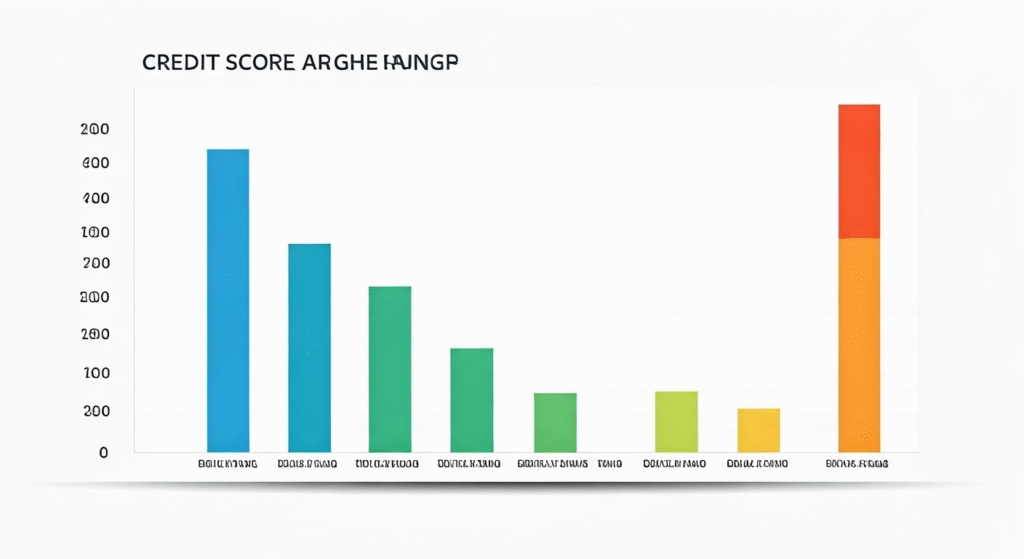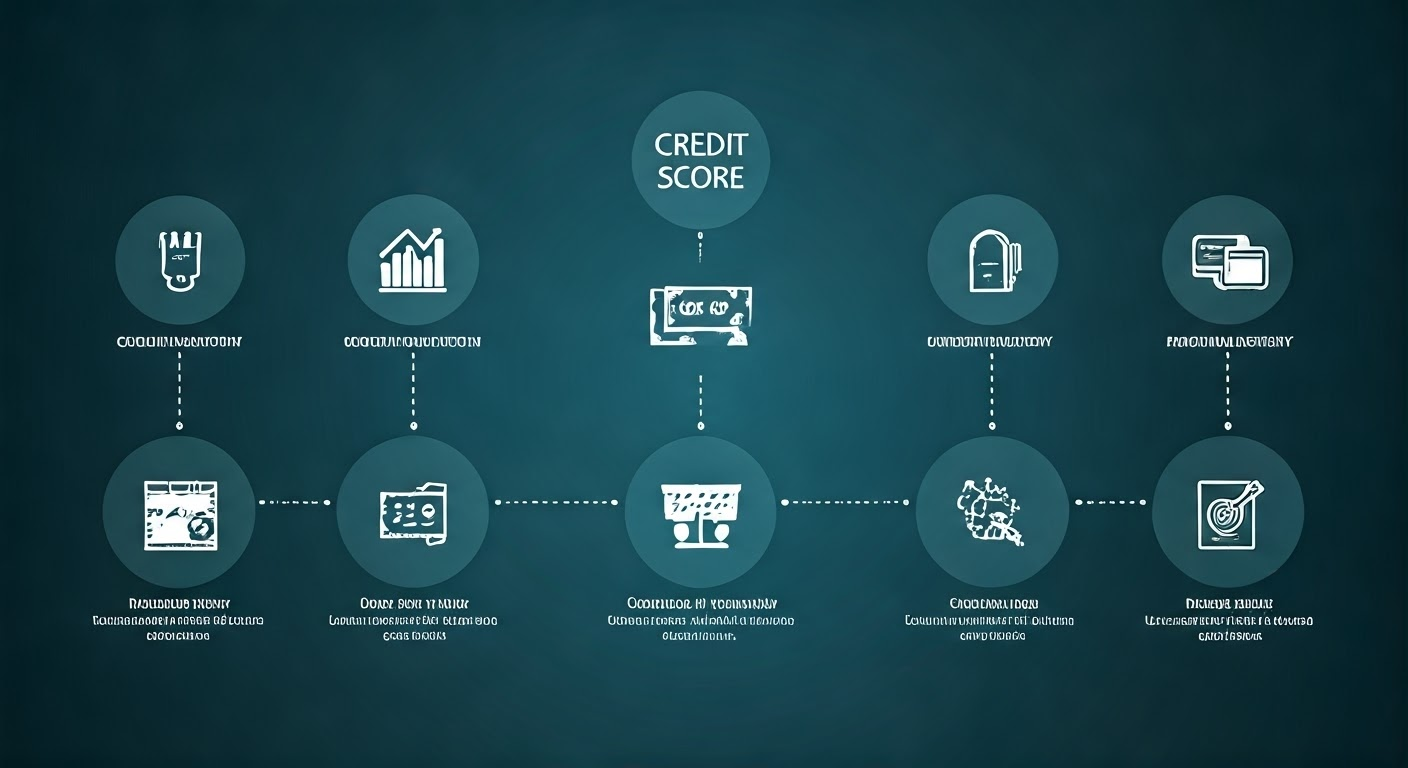


Your credit score is an important financial tool. It shows how well you manage money. This three-digit number comes from your credit report. Lenders use it to see your credit risk based on your past credit history. When you apply for a loan, a mortgage, or a new credit card, your credit score is very important. It helps decide if you are approved and what interest rates you get. Having a strong credit history makes it easier to get good terms and reach your financial goals. It’s key to understand how credit scores work to improve them over time.
A credit score is a number between 300 and 850. This three-digit number shows how creditworthy you are. It is calculated using scoring models that look at factors like your payment history and credit utilization rates.
Lenders look at credit scores to see if you will pay back your debts on time. The most common scores in the United States are FICO scores, which about 90% of lenders use. VantageScore is another type of scoring model that gives credit evaluations. Both of these models use data from major credit bureaus like Equifax, Experian, and TransUnion, but their methods may be a bit different.
Your credit score is important for getting loans, setting limits, and finding out interest rates. Each scoring model calculates scores in its own way to fit different situations.
Credit scores and credit reports are related but have different jobs. A credit report collects detailed information from lenders, public records, and your financial activities. It includes things like your payment history, total debt, and credit accounts. In contrast, a credit score comes from this report and gives a number that reflects your credit health.
Credit reports contain important credit information used by the three major credit bureaus: Equifax, Experian, and TransUnion. They use this to calculate your score. While lenders mostly rely on credit scores to make quick decisions, they may also look at the full credit report for more information.
Knowing the differences between these two is important for managing your financial profile. By checking both regularly, you can find mistakes in your credit information that might hurt your score.

Other aspects that shape your credit score include the length of your credit history, the types of accounts you have, and any new credit activity. Each part affects your credit score in different ways. This gives you chances to change your habits and work towards a good credit score. Let’s take a closer look at how each part influences your overall score.
Payment history has a big impact on your credit score. It makes up 35% of how FICO calculates scores. Making payments on time shows that you are financially reliable. In contrast, late or missed payments can lower your score. If accounts are sent to collections or you file for bankruptcy, it makes things even worse.
Lenders look at your payment history to see if you will pay back future credit. Information about your monthly payments for loans, mortgages, or credit cards is very important and is reported to credit agencies. Even one late payment can lower your score significantly.
By paying all your bills, like utilities and credit card dues, on time, you show that you have good credit behavior. This helps keep your score safe and increases your trustworthiness with lenders.
Credit utilization shows how much of your available credit you are using. This measure is important because it makes up about 30% of your credit score. When you use a large part of your credit limit, it may look like you rely too much on credit. This can lower your score.
To keep lenders happy, it’s best to keep your utilization rate below 30%. For example, if you have $10,000 in credit and you owe $3,000, your utilization rate is 30%. This is considered a good practice.
Lenders and credit bureaus pay attention to this rate. A lower utilization rate usually means you borrow responsibly. If you manage your available credit well and pay off debts quickly, you can lower your credit utilization rate. This will likely help improve your credit score.
The length of your credit history makes up 15% of your FICO score. A longer credit history helps lenders see how you’ve managed your credit over time. This includes how old your oldest account is and the average age of your current accounts.
Showing that you manage your credit well can show financial stability. But if you keep opening new credit accounts, you make the average age of your credit history shorter. This can hurt your score.
So, the key is to keep older accounts, even if you don’t use them much. These accounts show that you can handle credit responsibly for a long time. This builds trust with creditors and can help improve your score.
Having different types of credit is important for good financial management. It makes up 10% of your FICO score. Using a mix of credit, like credit cards, car loans, and mortgages, shows lenders you can manage various types responsibly.
For instance, credit cards are a flexible option. On the other hand, car loans or personal loans are a good way to show you can make steady payments. Keeping both kinds can improve your credit profile and raise your score.
If your credit history does not have much variety, lenders might think you are inexperienced. Expanding your credit mix while being careful can strengthen your profile. This can make you more attractive for credit opportunities.

Your credit report gives details that show how these factors affect your score. By understanding how this calculation works, you can work on specific areas to improve your score. This can help you get higher scores and better credit terms.
Credit scoring models, like FICO and VantageScore, use specific details from credit reports to measure risk. These details include your payment history, credit utilization rate, credit mix, new accounts, and the age of credit.
FICO focuses more on payment behavior. In contrast, VantageScore places more importance on how you use credit over time. It’s important to know that soft inquiries or personal details like age and marital status do not affect your score.
This customized method helps lenders achieve their goals. It allows them to evaluate different types of credit accounts more effectively.
FICO and VantageScore are the two main types of credit scoring models, but they work differently. FICO scores go from 300 to 850 and look at things like payment history and how much money you owe. On the other hand, VantageScore also uses similar score ranges, but it takes a wider view. It checks credit habits, including trends in how you use your credit over time.
Where FICO thinks an account is old after six months, VantageScore can give scores for newer credit histories. Also, VantageScore allows the use of trended data. This gives lenders valuable insights for their decisions.
Each model is useful in different lending situations, so it is smart for consumers to keep an eye on both scores.
Credit scores are put into groups that show how people handle money. There are five main groups: poor, fair, good, very good, and excellent. These groups help lenders see the risk of lending money.
For FICO, a score over 670 is good. For VantageScore, a score of 661 and up is seen as favorable. These score groups can impact loan interest rates, credit card offers, and credit limits. Knowing your score and how to improve it can help you take advantage of financial opportunities.
Credit scores typically follow these ranges:
| Range | FICO | VantageScore |
|---|---|---|
| Poor | 300–579 | 300–600 |
| Fair | 580–669 | 601–660 |
| Good | 670–739 | 661–780 |
| Very Good | 740–799 | 781–850 |
| Excellent | 800–850 | Above 850 |
Higher scores denote responsible credit use, while a poor score highlights risky financial behavior. Whether it’s for loans, credit cards, or mortgages, aiming for “Good” or higher improves access to favorable interest rates and terms.
Your credit score can be a key to your financial freedom or a roadblock. Having an excellent or very good score helps you get better interest rates, higher credit limits, and special credit card rewards. A good score is still helpful, but it might come with stricter rules, like higher rates.
If your score is fair or poor, it can limit your choices a lot. You might only qualify for loans with high fees and low limits. Lenders look at the risk linked to each score range. This affects your chances of growing financially.

Let’s look at some clear strategies and common mistakes. This can help you strengthen your financial situation and get better chances for credit.
To improve your credit score, you should pay your bills regularly and on time. Keeping a perfect payment history prevents issues that can lower your score. Also, lowering your high credit card balances will help create a good credit utilization ratio.
Try to have different types of credit. Use both revolving accounts and installment loans to show you can manage various kinds. You might also contact your issuers to ask for higher limits, which can immediately lower your usage rates.
Be careful not to overspend or close accounts too soon. A careful and smart plan helps create lasting positive trends in your credit score.
Mistakes such as paying late often and going over your credit limit can hurt your score a lot. When you apply for many new credits in a short period, it can cause hard inquiries that can also damage your score.
If you don’t check your credit report for mistakes, you might have wrong information that brings down your score. Closing old accounts can also hurt your credit history length. This can lower your available credit and harm your utilization ratios.
Fixing these errors quickly and making smart financial choices is important for keeping your credit health in good shape over time.
Checking your credit score often is very important. You can use free credit score services from companies like Equifax or Experian to keep informed. Begin by looking at your credit report information. Find any mistakes and fix them by reporting disputes.
Regularly checking your score helps you understand how your choices affect it. It also warns you about problems like identity theft or accounts you didn’t open. By keeping up with these checks, you can make sure your credit record is correct and clear. This helps improve your financial health.
Each credit reference agency uses its own scoring system, but as a general rule, the higher your credit score, the better your chances of being approved when applying for credit.
Keep in mind that this score may differ from what lenders and service providers actually see. They take into account additional factors beyond just your credit report. Still, your credit score gives a helpful snapshot of your overall financial health at any given time.
Here are some example credit scores from the credit reference agencies used by Lloyds Bank:
It is important to understand your credit score. This score shows how trustworthy you are financially. It helps you get loans, credit cards, and even rent a place. Knowing the main parts of credit scores can help you manage and improve yours. Key parts include payment history, credit utilization, and types of credit accounts. Checking your credit report regularly can help you find mistakes and see what might hurt your score. A higher credit score can lead to better interest rates and financial products. Start your journey toward a better credit score today!
You should look at your credit score at least once a year. This is important to do before you apply for major credit options. Use free credit report tools from the three main credit bureaus: Equifax, Experian, and TransUnion. This helps you keep track of your credit and protects your credit health from mistakes or fraud.
Canceling a credit card can affect your credit history and available credit. Closing older accounts makes your credit history shorter. It also lowers your total credit limits, which might raise your credit utilization rate. Lenders like it when you keep accounts open with zero balances rather than closing them.
To fix mistakes, send disputes straight to the credit bureaus—Experian, Equifax, or TransUnion. Include proof such as receipts or correct documents. Most investigations get done in 30 days. This helps make sure your credit file and report information are right, which protects your score.
To raise your scores quickly, focus on paying bills on time and keeping your credit use low. Ask for higher credit limits, but do not spend more. Use services like Experian Boost to include rent and utility payments in your credit file. Stay away from hard inquiries by not applying for new credit.
Building a good credit score can take a long time, from months to years. This depends on things like your payment history, utilization rate, and the types of credit you have. To help improve your score, make consistent payments. Also, grow your credit accounts responsibly and try to minimize hard inquiries. Over time, these actions can lead to a better score.
Understanding what influences your credit score makes it much easier to interpret credit checks. Discover more insights and tips at the Finance Monitoring Guide.
(+1) 5165229807
info@financemonitoringguide.com
500 Marquette Ave NW, Suite 1200 Albuquerque, NM 87102 United States